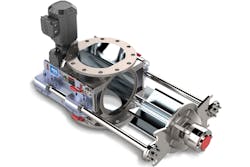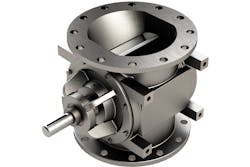Whether you’re a manufacturing veteran or just getting started with a new facility, the National Fire Protection Association’s (NFPA) complex web of regulations can be difficult to navigate on your own. This glossary of NFPA and fire safety terms will help you get acquainted with the rules as they apply to rotary valves and processing.
A is for airflow
Rotary airlocks seal the airflow between the inlet and outlet of valves, allowing material to travel efficiently through a conveying system. Air leakage causes tiny particles of material to rise into the air or land on surfaces in the facility, creating the potential for major problems like fires and explosions.
A conveying system needs proper ventilation to prevent these types of air leakage issues. Talk to a valve manufacturer to make sure the right airlock is chosen for the application, and then replace the rotor when necessary to keep clearances tight.
C is for combustion
Combustible dust can act as the fuel for an explosion in a processing plant. The NFPA defines combustible dust as a fine, solid particle that "presents a flash fire hazard or explosion hazard when suspended in the air," or when it comes in contact with certain concentrations of oxidizing media specific to the process.
Combined with an oxidizer and an ignition source, combustible dust can cause dangerous deflagrations in your plant.
D is for deflagration
When a heat source moves over cold materials (or combustible dusts) and ignites them, it can cause a deflagration. Deflagration fires generally spread quickly, moving along a line as other hot materials ignite. They can be difficult for fire crews to handle, posing a great risk to the manufacturing plant and worker safety.
Valves act as isolation devices in these situations. To keep valves compliant, check the rotor-to-housing tolerances for maximum safety.
F is for fire
A fire can break out under a combination of specific conditions. The basic formula involves fuel, an oxidizer and an ignition source. In the processing industries, combustible dust is the most likely fuel source. When those three elements come together, they can spark a potentially dangerous fire.
Regular cleaning schedules, combined with routine maintenance on valves and other machinery, go a long way toward preventing fires.
H is for hazard (as in dust hazard analysis)
Dust Hazard Analyses (DHAs) assess the fire and explosion risks of combustible dusts in a processing plant. According to NFPA 652, they are mandatory for any facility that handles, generates or stores combustible dusts.
There are several different types of DHAs, like the Hazard Operability Analysis (HAZOP) and the Checklist Analysis. The analyses will help process engineers understand how to mitigate hazards and prevent facility accidents.
MD Series rotary valve
I is for ignition
Ignition is a key ingredient in the recipe for manufacturing plant fires, along with fuel and oxygen. A few different scenarios could lead to ignition:
- Material temperatures on a conveying line rise too high. This can happen with heat-sensitive bulk materials like resins, food powders and sugar.
- Increased rotor speeds or axial shaft movements cause enough friction to spark a fire. Friction can also happen when materials drag or build up.
- In a positive-pressure conveying system, compression can elevate the amount of air entering the system, leading to ignition.
To prevent fires, make sure to transport heat-sensitive bulk materials under the correct temperature, humidity and conveying gas conditions. Also avoid friction by specifying the right types of outboard bearings — ones with temperature switches to detect excessive heat — and shaft seal assemblies, which should reduce heat and static electricity.
O is for oxidizer
The oxidizer is one of the three main elements of a processing plant fire. When a high concentration of oxygen leaks from the system, or when there is lack of proper ventilation at some point in the conveying line, the presence of fuel and ignition can spark a fire.
Keep an eye on the ventilation systems in the plant to make sure they’re always functioning at full capacity.
R is for rotor-to-housing clearance
Rotary valves can slow down the spread of flames in a conveying line, as explained below. To make sure they’re fully functional and NFPA-compliant, regularly check the rotor-to-housing clearances (or tolerances) on the valves. If the clearances rise above 0.0079 inches, the rotor will need to be replaced.
V is for valve
Valves play a critical role in controlling the conditions that lead to fires and explosions in processing plants. As isolation devices, rotary valves can stop the spread of flames along a conveying line. They can also regulate fuel and ignition sources to reduce the amount of oxygen feeding a fire.
For optimal fire safety, valves should be properly maintained and equipped with the right features.
Now you know your ABCs. NFPA compliance can be tricky, but becoming familiar with rotary valve fire safety features and consulting with a trusted manufacturer and expert in NFPA compliance can help keep your processing lines running properly and your workers safe.
Megan Thompson is president and chief operating officer of ACS Valves. Thompson is an NFPA expert with 26 years of experience in the industry helping plants prevent explosions and keep workers safe.

